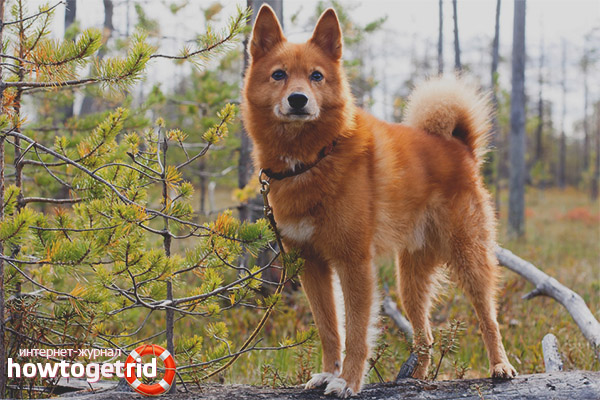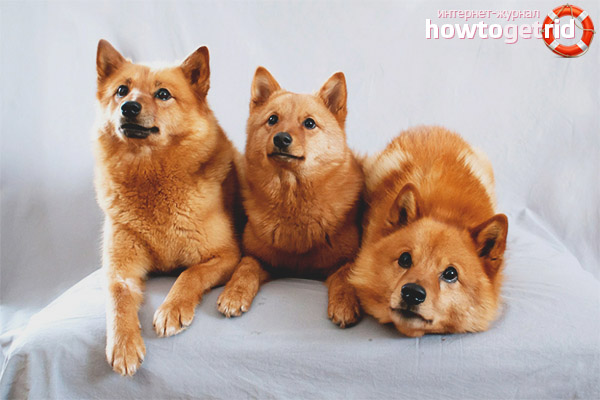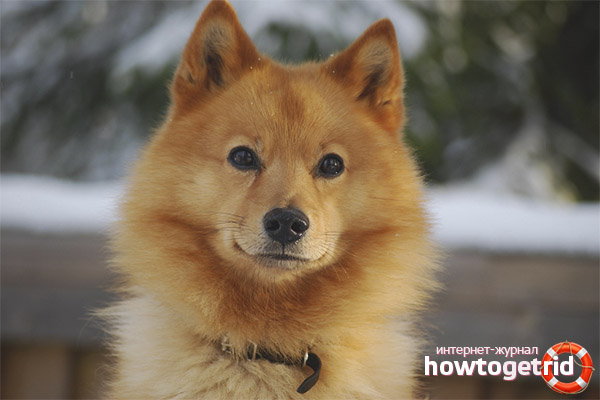The content of the article
Externally, the Karelian-Finnish husky is very similar to foxes, so sometimes they can be called Finnish spitz. The breed has common roots with the Karelian bear husky, although it is smaller in size, and the nature of the Karelian-Finnish huskies is much more benevolent and not a bit inferior in hunting qualities. Dogs of this breed are loyal, cheerful, intelligent and energetic. In addition to calling for hunting, representatives of the Karelian-Finnish husky breed can be a faithful companion and reliable guard.
History of origin
It is believed that the ancestors of the current Finnish Spitz were hunted along with the ancient man in ancient times. In the 19th century, high noblemen did not agree to consider huskies as hunting dogs.And only in the north of Russia the smart husky was taken with them to hunt, where once the Russian prince Shirinsky-Shikhmatov was fascinated by fiery-red hunting dogs. The dogs accompanying the baiting, the dogs so subdued the nobleman with their ingenuity, tremendous hunting qualities and intelligence that the prince noted the geographical habitat of the breed - the territory of Karelia, Arkhangelsk and Leningrad regions, as well as Finland.
Yes, the beginning of the 20th century, the breed was formed independently. Inside the distribution area, representatives of the breed interfered with blood with other types of domestic dogs, they were attracted to hunt. Survived the strongest, physically and mentally-developed dogs with pronounced qualities of hunting skills.
At the end of the 19th century, two fiery red huskies were brought to the capital of this country by Finnish hunters from the outskirts of Finland. After 12 years, these dogs were allocated to a separate breed under the name "Finnish Spitz". By the 50s of the last century, this breed became known to all dog breeders of the world. The Karelian-Finnish Laika was registered in 1947 as a modern breed.
Characteristic breed signs
Karelo-Finnish huskies are distinguished by luxurious wool of bright red color and remarkable working qualities of a hunting dog. These are energetic and mobile individuals, perfectly oriented during hunting with excellent response. The hunt is the real love of the Karelian.
According to the regulations of the breed, the shape of the head of the Karelian is wedge-shaped, the muzzle stands out clearly. The almond-shaped dark eyes look slightly slanting and are notable for their expressive look. Small sharp triangular ears in the standing position are covered with fine wool. The body is dry and compact with a strong back and raised withers. The tail is curled ring, without refractions. Paws are elegant, round shape with black pads. The backbone of the dog is strong and dry with good posture.
The length of the hair varies - on the face and the front lower part of the paws, it is short, and on the neck, withers, and the back of the paws - rather long, it forms “pants”. On the cheeks wool looks like sideburns. The beautiful tail is covered with dense and long hair.
The color of fur can vary from bright red, red to golden brown with soft light transitions.Also according to the standard, a white spot on the chest and small grooves on the legs are permissible. On a standard exterior, a Karelian-Finnish husky is fairly easy to identify.
The positive side of the Carelet:
- stable mental state;
- minimum dog grooming;
- cleanliness;
- good health, long life expectancy;
- versatility (acts as a companion, family dog, ideal for hunting).
Negative sides:
- stubbornness;
- huge appetite, even gluttony;
- hard to train.
Character
The Karelian-Finnish husky is an easily excitable and emotional dog with a cheerful character. Being at a young age, the young Karelka will diligently carry out the commands of all the household, not even trying to single out his master from them. For her, order and cleanliness, mutual relations with owners and attachment to her place are important. Despite the desire to please everyone, the Karelka is independent and independent. This is especially noticeable on the hunt - the dog is guided only by their own thoughts.
The Karelian-Finnish Laika is friendly and rarely comes into conflict with other dogs.
Due to her natural vigor, Karelka is happy to play with her master's children and calmly treats their pranks. Relationships with other pets are also favorable, especially if the animals were raised at the same time.
Despite the fact that the breed specializes in hunting skills, the guard and guard qualities of the Karelian are well developed. Dogs are endowed with excellent hearing and instant reaction. With strangers, the Karelian behaves intensely and suspiciously, but one should not expect an unwarranted aggression from a dog.
Training
When training Karelian-Finnish huskies, you should rely on your own dog skills and use them when mastering commands. Best of all, carrels perceive training in the form of a game, when the owner actively attracts the sharp scent and delicate hearing of the dog. Advancement in the training of the Karelian is never quick; one should be patient. Karelian-Finnish huskies are easily distracted, so it’s worth training with a minimal amount of external stimuli.
If it was decided to train a dog handler, then choose a professional with the practice of training hunting dogs. Since Karelian-Finnish likes at a young age is difficult enough to concentrate - it is worth giving your choice in favor of individual training.
It should be noted a huge hunting instinct of Karelian-Finnish laika dogs, due to which a puppy can start working with a hunter-owner already at the age of six months. Karelka is gambling and sometimes it’s enough just to come to the forest so that the puppy starts working independently.
Karelka has a mobile nervous device, which allows her to easily change one type of hunt for another. Adherence to the owner means a high degree of obedience of this dog. Carrels are indispensable companions on the hunt due to their proper excitability, calm excitement, loud barking.
Example: one day the husky will bark squirrel from morning to evening, and the next day will gladly set off to bait a large animal, for example, a boar. Such dogs often dislike water, but they will unquestionably jump into the river behind a fallen bird and deliver it to their hunter.
But, if there is no desire and need to engage in hunting the dog, the Karelian-Finnish laika will gladly make a family company. She will delight the household with her joyful and playful character.
Features care for Karelian-Finnish likes
Representatives of this breed flaunt a luxurious fur coat, which is characterized by the absence of a typical dog smell. Huskies are very clean and do not tolerate dirt.
- The dog experiences molting twice a year when the temperature regime changes - in the fall and spring. If the Karelian-Finnish Laika starts to fade constantly, then the reason is most likely that the humidity in the pet room is too low. If dandruff appears in the wool of a husky, then the dog needs to be shown urgently to the veterinarian and receive recommendations on changing the diet.
- Bathing a dog requires no more than a couple of times a year. A greater number of bath procedures can remove the natural film from the hairs of wool. Of course, hunting waterfowl, Karelka will constantly take water procedures. After such a bath, the owner will certainly have to gently wash the pet with clean water.
- But the "dry" care for the chic wool of the cartel is required regularly, therefore, at least 3 times a week the owner should comb the fur coat of the animal with a special metal comb. This procedure is pleasant for the dog, perfectly massages the skin under the hair and most importantly - successfully removes dead hair.
- At the same time, as a weekly procedure, the host must carefully treat the auricle to the husky, carefully monitoring the absence of possible inflammation. Signs of inflammation are both a painful symptom and the appearance of an unpleasant smell from the ear or the appearance of fluid.
- Twice a week it is necessary to take care of the teeth of the dog, brush them with a brush or a special nozzle. To clean a pet's teeth from tartar, it is necessary to regularly treat it with solid food and sometimes fresh tomatoes.
- Every month, the dog needs a manicure in the form of claw trimming.
- As a daily procedure, the owner of the Karelian-Finnish husky should check the eyes of the animal - if mucus accumulates in the corners, remove it with a cotton sponge or a clean rag.
IMPORTANT! In the case of unusual changes in the appearance of your dog, especiallyIf any painful symptoms appear during sanitization, you must immediately show the dog to the veterinarian. You should not look for answers on the Internet, self-medicate and postpone a visit to the doctor.
Do not forget to make the dog mandatory vaccinations. Constantly carry out preventive treatment for fleas. During the seasons of tick activity, the dog’s skin should be checked after each walk in order to avoid tick bites and subsequent problems. The most dangerous periods of tick activity are May, July and September. Neglecting the protection of the dog from ticks can lead to infection of the husky with piroplasmosis and, as a result, lead to the death of the pet.
The choice of the necessary drug for ectoparasites should be done in conjunction with a veterinarian.
Karelian-Finnish husky is acceptable to keep both in a private house and in a regular apartment. In the case of living in an apartment, the like should be provided with constant long-term walking and the possibility of systematic physical exertion. Karelian walking should be carried out at least 2 times a day, not less than 2 hours. If you ignore these rules, the pet can make the owners an unpleasant surprise at home, having pretty badly messed up.
When kept in a private house, the dog must be provided with a safe enclosure with the possibility of physical activity. Huskies are extremely freedom-loving dogs, which are absolutely contraindicated to stay on a chain or in a closed room. From this content, the carrels can become ill with depression.
Food of the Karelian-Finnish husky
Carrels have an enviable appetite and ability to eat before overeating. Therefore, the owner should closely monitor the dog's diet.
Husky feed can consist of both high-quality and ready-made purchased feed, and of a natural diet. When choosing the latter, it is important to maintain a balance in the dog's nutrition regarding vitamins and minerals.
Feeding a puppy occurs from 5 to 6 times a day. Adult pet eats 1-2 times a day. The natural diet is given to the dog at a strictly room temperature, and feeding occurs within 15 minutes. After the end of this time, the bowl with food should be removed from the feeding place. Be sure to have free access for your pet should be clean drinking water.
Buying a dog
First of all, when choosing a dog, pay attention to the health of the baby - such puppies are plump, muscular and differ in proportional physique. Wool of young huskies in a healthy state is thick, without bald spots. The future pet's eyes are clean and clear.
The most important sign of the good character of your future partner is the willingness to easily get closer to people, courage. Such puppies are active, energetic, easy to go to people and not afraid of loud and unexpected noise. The cost of a puppy of Karelian-Finnish husky starts from 5 thousand and can reach 25 thousand rubles.
For dogs of this breed, bite defects are not allowed, the color of the nose is bodily, the pigmentation of the eyes is blue or yellow. Also, dogs are rejected in the presence of white spots on the chest or paws and wavy or curly hair on the body. Hostile behavior towards people is unacceptable.
Video: Karelian-Finnish Like dog breed














To send